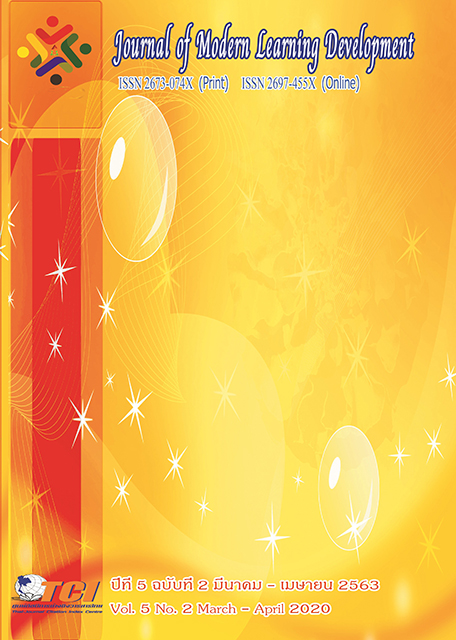A Study of Learning Achievement in Learning Unit of Rattanakosin Era History of Matthayomsuksa 3 Using the Historical Method and Mind Mapping
Main Article Content
Abstract
This experimental research aimed to 1) compare the learning achievement in the learning unit of Rattakosin Era History of Matthayomsuksa 3 students before and after the use of the historical method and mind mapping and 2) study the satisfaction of Matthayomsuksa 3 students who studied with historical method and mind mapping. The population used in this research were 239 Matthayomsuksa 3 students/ 8 classes who studied in semester 1/2020 in The Demonstration School of Ramkhamhaeng University (Secondary School). The sample were selected by simple random sampling method, which were 40 students in Matthayomsuksa 3/6 by doing draw lots. The One Group pretest-posttest design was used in this research. The research instruments were consisted of 1) learning plan of Rattanakosin Era History subject in Matthayomsuksa 3 level using the historical method and mind mapping, which the consistency index value (IOC) was very high at 4.61. 2) The 30 questions multiple-choice history test, each question with 4 choices, in Rattanakosin Era subject in Matthayomsuksa 3 level. The IOC level was between 0.67-1.00. Additionally, the difficulty level which the difficulty level, discrimination level, confidence interval level were 0.50-0.75, 0.25-0.63, 0.92. 3) The questionnaire of Matthayomsuksa 3 students satisfaction towards using the historical method and mind mapping, which IOC level was 0.67-1.00. The data were analyzed in terms of mean, standard deviation and t-test independent Group.
The research results found as follow:
1.The post-learning achievements in Rattanakosin Era history subject of Matthayomsuksa 3 students using historical method and mind mapping were significantly higher than pre-learning at the 0.01 level.
2.The students satisfaction toward using historical method and mind mapping was significantly high with the mean being 4.45.
Article Details
References
กระทรวงศึกษาธิการ. (2551). หลักสูตรแกนกลางการศึกษาขั้นพื้นฐานพุทธศักราช 2551. กรุงเทพมหานคร: กระทรงศึกษาธิการ.
ธัญญา ผลอนันต์. (2551). ใช้หัวคิด/Use Your Head. (พิมพ์ครั้งที่ 4). กรุงเทพมหานคร: ขวัญข้าว94.
พรกมล จันทรีย์. (2562). ปัญหาการจัดการเรียนการสอนวิชาประวัติศาสตร์ไทยในระดับตอนต้น สังกัดกรมสามัญศึกษา ในเขตกรุงเทพมหานคร มหาวิทยาลัยรามคำแหง.กรุงเทพมหานคร: มหาวิทยาลัยรามคำแหง.
เพลินจิตร โพธิ์กระจ่าง. (2554). การเปรียบเทียบผลสัมฤทธิ์ทางการเรียนวิชาสังคมศึกษา ศาสนา และวัฒนธรรม ทักษะการทำงานกลุ่มและความพึงพอใจในวิธีการจัดการเรียนรู้แบบร่วมมือที่เน้นผลสัมฤทธิ์กับการจัดการเรียนรู้แบบปกติของนักเรียนชั้นมัธยมศึกษาปีที่ 2. ศึกษาศาสตรมหาบัณฑิต หลักสูตรและการสอน. บัณฑิตวิทยาลัย: มหาวิทยาลัยรามคำแหง.
รุจิเรข จันบัติ. (2553). การศึกษาผลสัมฤทธิ์ด้านทักษะการเขียนภาษาอังกฤษของนักเรียนชั้นมัธยมศึกษาปี ที่ 1 โรงเรียนศรีกระนวนวิทยาคม โดยใช้แผนผังความคิด. ศึกษาศาสตร มหาบัณฑิต. บัณฑิตวิทยาลัย: มหาวิทยาลัยขอนแก่น.
สำนักงานคณะกรรมการการศึกษาขั้นพื้นฐาน. (2551). Curriculam issues 2010 เอกสาร เพื่อประชาสัมพันธ์หลักสูตรแกนกลางการศึกษาขั้นพื้นฐาน พุทธศักราช 2551. กรุงเทพมหานคร: โรงพิมพ์ ชุมนุมสหกรณ์การเกษตรแห่งประเทศไทย.
สุคนธ์ สินธพานนท์. (2550). สุดยอดวิธีการสอนสังคมศึกษาศาสนาและวัฒนธรรม นำไปสู่การจัดการเรียนรู้ของครูยุคใหม่. กรุงเทพมหานคร: อักษรเจริญทัศน์.
เสน่ห์ ฉวยกระโทก. (2556). การศึกษาผลสัมฤทธิ์ทางการเรียน หน่วยการเรียนรู้ประวัติศาสตร์รัตนโกสิน และความสามารถในหารคิดวิเคราะห์ของนักเรียนชั้นมัธยมศึกษาปีที่ 4 จากการใช้วิธีการทางประวัติศาสตร์ร่วมกับผังความคิด. วิทยานิพนธ์ศึกษาศาสตรมหาบัณฑิต. บัณฑิตวิทยาลัย: มหาวิทยาลัยราชภัฏนครราชสีมา.
ไสว ฟักขาว. (2542). การจัดการเรียนการสอนที่เน้นผู้เรียนเป็นศูนย์กลาง. กรุงเทพมหานคร: เอมพันธ์.
Buzen,Tony and Barry Buzan. (1997). The mind map book : Radiant thinking. London: BBC Book.


